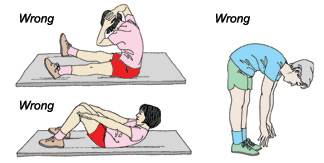 Recent reports of new statistics on osteoporosis have not been substantiated, but new concerns about safety of osteoporosis drugs and calcium supplements have recently re-focused attention on proper posture and movement techniques to avoid bone fractures, as well as other natural preventive measures such as diet and proper exercise.
Recent reports of new statistics on osteoporosis have not been substantiated, but new concerns about safety of osteoporosis drugs and calcium supplements have recently re-focused attention on proper posture and movement techniques to avoid bone fractures, as well as other natural preventive measures such as diet and proper exercise.
Without citing any sources, a website reported on April 30, 2011, that “According to a new report released this week, 10 million people in the U.S. suffer from osteoporosis, a disease that results in very weak bones.” Many other sites then picked up and repeated this story as news, despite the lack of authority for any such “new report released this week” as alleged in the original website’s story.
In fact, the National Osteoporosis Foundation in its Osteoporosis Prevalence Report issued back in 2002, reported that,
“more than 10 million people already have osteoporosis [in 2002]. Approximately eighty percent of these people are women. This figure will rise to almost 12 million individuals by 2010 and to approximately 14 million by 2020 if additional efforts are not made to stem this disease, which may be largely prevented with lifestyle considerations and treatment when appropriate.”
The International Osteoporosis Foundation reports similar statistics and projections for the increasing prevalence of osteoporosis in the U.S., based upon the U.S. National Osteoporosis Foundation’s 2002 report.
So, the statistics are not new. But, the concern remains. For information about what is osteoporosis and its causes, see the National Osteoporosis Foundation’s site, or our resource pages on Arthritis, Osteoporosis & Rheumatic Conditions.
What is new?
What is relatively new is that the U.S. Food and Drug Administration in January, 2011 issued a Safety Alert on the bisphosphonate drugs that typically are used in attempts to prevent or treat osteoporosis. The FDA reported that these drugs, which the FDA said include Fosamax (alendronate sodium), Actonel (risedronate sodium), Boniva (ibandronate sodium), Atelvia (risedronate sodium), Reclast (zoledronic acid), and their generic equivalents, have been found to be associated with increased atypical bone fractures.
The FDA warned health care professionals to “be aware of the possibility of atypical femur fractures in patients taking bisphosphonates,” and recommended re-evaluating the use of these drugs, especially in patients who have been treated for more than five years.
“Periodic reevaluation is recommended because the fracture reduction efficacy of these drugs has not been established, and the optimal duration of use is uncertain,” the FDA cautioned.
Other new studies recently have found that use of calcium supplements, typically recommended in efforts to prevent osteoporosis, has been found to be associated with increased risk of heart attack.
Re-focus on Safe Means to Combat or Prevent Osteoporosis: Proper Posture, Movement & Exercise
With the prevalence of osteoporosis expected to continue rising according to the statistics reported in 2002, especially in women over age 50, and after these recent warnings by the FDA against excessive use of bisphosphonate drugs and new study findings calling into question excessive use of calcium supplements, increased focus has turned again to what safe measures can be used to combat and prevent the disease.
The National Osteoporosis Foundation (NOF) recently added a new page to its website on Moving Safely. The NOF explains that proper posture for good balance, and safe movement of your body are key to preventing bone fractures throughout your life, and especially if you have or are at risk of developing osteoporosis. This new post by the NOF includes a helpful primer for seniors, with diagrams and checklists on the do’s and don’ts of proper posture and proper movement and exercise to prevent bone fractures.
Unsafe Postures, Movements & Exercises
Some examples of unsafe postures and movements that the NOF advises you to avoid, include:
- A slumped, head-forward posture
- Bending forward from the waist
- Twisting of the spine to a point of strain
- Twisting the trunk and bending forward when doing activities such as coughing, sneezing, vacuuming or lifting
- Anything that requires you to reach far. An example is reaching up for an item on a high shelf, which also could cause you to lose your balance and fall.
- exercises that involve bending over from the waist, such as:
- Sit-ups
- Abdominal crunches (also referred to as stomach crunches)
- Toe-touches
Do’s and Dont’s of Posture & Movement Techniques
The National Osteoporosis Foundation’s new primer on Moving Safely also includes checklists and diagrams illustrating the right and wrong ways to do all of the following types of movements so as to avoid bone fractures:
- Sitting
- Standing
- Climbing Stairs
- Bending and Turning
- Lifting and Carrying
- Pushing and Pulling
- Coughing and Sneezing
- Getting into Bed
- Lying Down and Getting Out of Bed
The National Osteoporosis Foundation also provides general information on natural means of osteoporosis prevention through healthy living, advising that: “We have learned that getting enough calcium, vitamin D and regular exercise are important for your bones. Eating fruits and vegetables is also good for bone health. On the other hand, eating poorly, smoking, drinking too much alcohol or not exercising can cause bone loss and osteoporosis.”
The International Osteoporosis Foundation provides a list of studies on the prevention of osteoporosis through Exercise and Nutrition.
For more information on osteoporosis and its care and prevention, see:
* The National Institutes of Health’s MedlinePlus,
* The National Academy of Orthopaedic Surgeons, and
* Our resource pages on Arthritis, Osteoporosis & Rheumatic Conditions.
_____________
Copyright © 2011 Care-Help LLC












Recent Comments from our Online Community